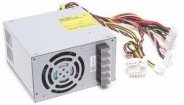Power and Your PC
By Jason Kohrs
The power coming into a computer is the most critical component, and it may be
one of the most overlooked. It is just taken for granted that it will always be
there and working properly.
A top of the line processor and ultra powerful video card do nothing if a system
does not receive the ample, stable power it demands. Having quality components
providing and regulating the power supplied to a computer is critical, and this brief
overview looks at a few areas worth consideration.
Power Supplies
Computer power supplies take the high (110V or 220V) DC voltages from an electrical
outlet and convert it to the various lower AC voltages required for a system to
operate. The typical voltages required inside a computer are 3.3V, 5V, and 12V,
where the 3.3V and 5V lines are generally used to power circuitry, and the 12V line
provides power to run items such as hard drives, optical drives, and cooling fans.
Power supplies are sold in terms of their total power output, in terms of
wattage. Choosing the correct power supply means not only finding one that will
provide enough power for all of the components connected to the system, but also
one that is the correct size physically, has enough connections for typical
drives and fans, and if necessary, that also has special connections for things
such as Serial ATA drives and modern video cards.
Choosing a power supply with enough power shouldn't be much of a problem, as
having more power than you need is never a bad thing. Just because a power
supply is rated for 400W, or perhaps 600W, does not imply that it is drawing
that at any given time. It just indicates the total power available to the
various lines inside the computer.

Power supplies come in a few different physical sizes, but the most common are
designed to fit the standard ATX and micro ATX (mATX) form factor cases. A
typical ATX power supply, such as this Echo-Star 680W unit, measures 3.25" x 6"
x 5.5" and features two cooling fans to not only cool the power supply, but to
also help draw hot air out of the computer.
| 
